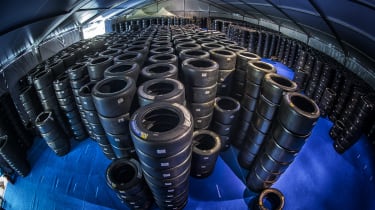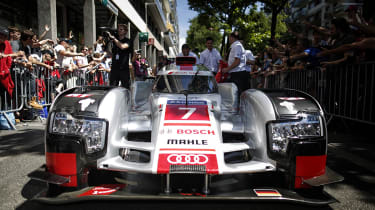Michelin at Le Mans - how tyres help win races
A look into behind the scenes at Le Mans with Michelin
Michelin’s Le Mans effort is a massive operation. The firm supplies the overwhelming majority of the grid, including all the leading LMP1 teams and the factory-backed GTE Pro squads. That requires 7,000 tyres over the course of the racing week, transported to La Sarthe in 15 trucks, an army of 50 tyre fitters working on three fitting lines, and 15 tyre engineers.
Jerome Mondain, manager of Michelin’s endurance program, explains what makes Le Mans a special challenge: “Le Mans is characterised by very high speed,” says Jerome with a chuckle. “It’s not a permanent circuit, so it’s difficult to design a tyre for it: it’s the main race of the championship, but we never have a chance to run here so a lot of work is done with simulation. The track here is very long, and most of it is also smoother than other tracks because it’s a public road. This makes it less abrasive.”
>Watch - evo's ultimate road trip to Le Mans in a Ferrari 458 Speciale and Porsche 911 GT3
Michelin offers five or six different compounds to their teams, depending on the class of car. These consist of three ‘slick’ tyres for dry conditions, and three ‘wets’. Advising which tyre to use, and when, is the job of the Michelin engineer. “We have one engineer per team, or two engineers if there are three cars in the team. They are the link – they will advise anything about the tyre and coordinate with our workshop to inspect them, checking the pressure, the temperature, the wear and also getting the drivers’ comments in order to advise the team later on. The job of the engineer is scientific but it also requires experience. For example, in wet conditions they’ll only see a small section of the track, they’ll have some information, and the team will ask ‘which ‘wet’ do we use?’ You don’t have five minutes to think about it, the answer must be immediate.”
The Michelin engineers monitor the pressure in the tyre constantly, mainly to detect the onset of a slow puncture – a major safety hazard at a high-speed circuit like Le Mans. When the car arrives in the pits, the temperature of the tyre is taken by inserting a probe deep into the compound. “We could read the surface temperature of the tyre with a laser,” remarks Jerome, “but the tyre is very sensitive to the track surface and that would only tell us the temperature of the pitlane. So we go deeper as the tyre has 45 seconds of ‘memory’ in there.”
Although Michelin offers every team the same compounds as a starting point, its engineers will work closely with the top teams to develop specific tyres for their needs. “It takes a lot of time,” says Jerome, “so privateers tend to use an existing tyre we choose for them based on our knowledge of their car. In LMP1 and GTE Pro they’re free to do what they want – they can put an extra groove in the ‘wet’ if they choose – whereas LMP2 and GTE Am is more of a spec tyre. The tyres for the LMP cars have to take into account the larger aero loads, but the GT cars are heavier. Even within the classes the requirements differ, so for example the Porsche 911 has a rear engine so they have a different range of tyres due to the characteristics of the car.”
Michelin has a dedicated slick tyre for colder running at night, and a ‘magic’ hybrid ‘intermediate’ compound that’s a slick tyre for damp conditions. “It’s a new development,” says Jerome proudly, “the drivers say it’s really impressive. You can run on dry parts of the track as well without graining.”
The technology within this ‘magic’ tyre has now been transferred to the new Michelin Cross Climate road tyre, just as the original Pilot Sport road tyre was developed from experience gained here. It’s that thirst for knowledge and will to make an even better tyre that drives Michelin’s extraordinary commitment at the Le Mans 24-hour race.







